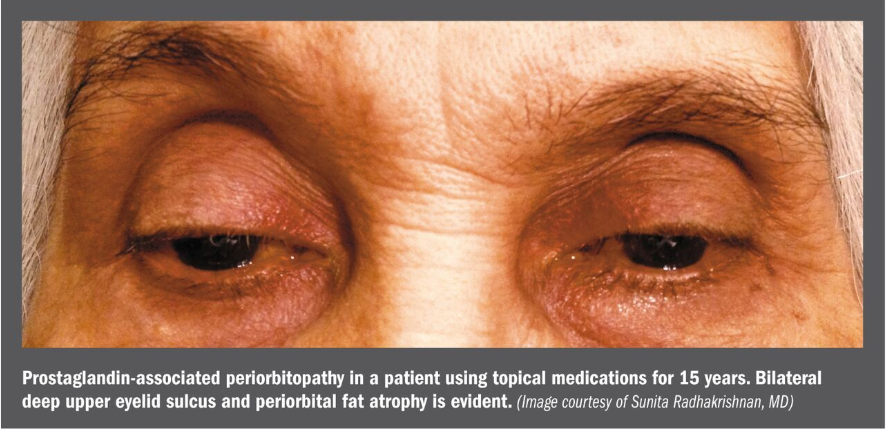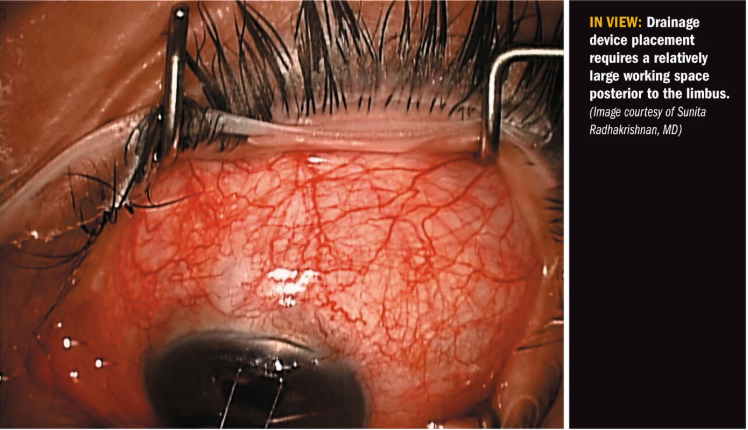Publication
Article
Digital Edition
When glaucoma and orbit collide
Author(s):
Orbital and adnexal anatomy and pathology can affect IOP and its measurement as well as planning of glaucoma surgery, and these structures can be affected by medical and surgical treatment of glaucoma
Prostaglandin-associated periorbitopathy in a patient using topical medications for 15 years. Bilateral deep upper eyelid sulcus and periorbital fat atrophy is evident. (Image courtesy of Sunita Radhakrishnan, MD)


Orbital and adnexal anatomy and pathology can affect IOP and its measurement as well as planning of glaucoma surgery, and these structures can be affected by medical and surgical treatment of glaucoma.
Reviewed by Sunita Radhakrishnan, MD
Glaucoma specialists need to think outside the globe because there are multiple considerations pertaining to the orbit and adnexa in patients with glaucoma, said Sunita Radhakrishnan, MD.
“Pathology of the orbit can be a cause of elevated IOP, and the anatomical configuration of the orbit and adnexa may have implications for planning glaucoma surgery,” said Dr. Radhakrishnan, private practice, Glaucoma Center of San Francisco, San Francisco.
“On the other hand, glaucoma treatments, including medications and surgery, can cause periorbital and adnexal changes.”
Some orbital pathologies that can cause an increase in IOP include thyroid eye disease (TED), arteriovenous fistulas, and superior vena cava obstruction. Increased episcleral venous pressure is the underlying mechanism. Dr. Radhakrishnan noted that TED is the most common orbital cause for increased IOP, but a dural carotid-cavernous fistula which is a low flow arteriovenous fistula, is the diagnosis that is most likely to be missed.
“A dural carotid-cavernous fistula usually presents with prominent episcleral vessels and elevated IOP, but the diagnosis may be missed because it is associated with minimal proptosis,” she said. “Establishing the diagnosis is important because dural carotid-cavernous fistula can often be cured with endovascular intervention.”
Before planning surgery for uncontrolled IOP, the possibility that orbital and lid anatomy is affecting the accuracy of IOP measurement should be considered. For example, prostaglandin associated periorbitopathy (PAP) that can develop in patients on long-term treatment with a topical prostaglandin analogue can be associated with a horizontally tight upper eyelid that makes applanation challenging and results in artifactually elevated IOP.
“In patients with PAP, it may be difficult to raise the upper eyelid enough so that it clears the top of a Goldmann applanation prism,” Dr. Radhakrishnan said. Tonometers that have a smaller area of corneal contact (like the Icare rebound tonometer) can be helpful in these patients.
Restricted ocular motility in patients with TED caused by a tight inferior rectus muscle can also lead to artifactually high IOP. Measuring applanation IOP in slight downgaze may be useful for addressing this issue. The lid and orbital anatomy also have implications for choosing the type of glaucoma surgery.
“For example, placement of a drainage device may be a better option than filtration surgery in a patient who has eyelid retraction or a bulging globe relative to the orbital rim,” Dr. Radhakrishnan said. The surgical site exposure is affected by the size of the palpebral fissure and is also a factor in choosing the type of glaucoma surgery. For example, in patients with small palpebral fissures, minimally invasive glaucoma surgery (MIGS) that can be performed via a temporal clear corneal incision may be the preferred option rather than traditional glaucoma procedures, such as filtration surgery or drainage devices that require a larger working space posterior to the limbus.
Adequate surgical site exposure for these procedures can usually be achieved with a good corneal traction suture, Dr. Radhakrishnan said. In patients with very small palpebral fissures who require drainage device placement, a canthotomy and cantholysis may be necessary to release the eyelid from the globe and allow access to the region 8 to 10 mm posterior to the limbus where the device plate is sutured to the sclera.
As a postoperative consideration after placing a drainage device, it may be difficult to detect a posterior erosion in patients with a tight orbit or small palpebral fissure. If infection is suspected, visualization can be improved using a lid speculum or eyelid retractor, although it may be necessary to wait a few days post-initiation of antibiotic treatment to perform the examination.
Glaucoma treatment-related effects
PAP is a well-known side effect of glaucoma treatment with prostaglandin analogues. In addition to horizontally tight upper eyelids, the features of PAP include upper lid ptosis, a deep upper lid sulcus, involution of dermatochalasis, periorbital fat atrophy, mild enophthalmos, inferior scleral show, and prominent lid vessels.
“According to several case reports, these findings are reversible when the prostaglandin analogue is stopped,” Dr. Radhakrishnan said.
Glaucoma medications have also been reported to cause ectropion. Dorzolamide appears to be the most common offending agent for ectropion followed by brimonidine. According to reports in the literature, these cases of medication-induced ectropion resolve partially or completely when the causative agent is discontinued, and patients are the potential for vision loss, Dr. Radhakrishnan said.
Management involves emergent decompression of the orbit with canthotomy and cantholysis of the lateral canthal tendon that connects the eyelids to the lateral orbital wall. After injecting local anesthetic, the skin at the lateral corner of the eye is clamped with a hemostat to achieve hemostasis. An incision is then made from the lateral canthus up to the orbital rim, and then the inferior crus of the lateral canthus tendon is cut; this enables the lid to move freely away from the globe.
“Inferior cantholysis is sufficient in most patients, but sometimes a superior cantholysis is also required,” Dr. Radhakrishnan said.
“Typically, the planned glaucoma surgery is postponed, and most patients heal well without needing canthal repair.” Glaucoma surgery can also affect adnexal anatomy. For example, filtration surgery may lead to ptosis, and a prominent bleb can cause eyelid retraction via a mechanical effect, although this complication appears to be rare.
Disclosures:
Sunita Radhakrishnan, MD
E: frontdesk@glaucomasf.com
This article was adapted from Dr. Radhakrishnan’s presentation at the Glaucoma Symposium CME during the 2018 Glaucoma 360 meeting. Dr. Radhakrishnan has no relevant financial interests to disclose.
Newsletter
Don’t miss out—get Ophthalmology Times updates on the latest clinical advancements and expert interviews, straight to your inbox.




